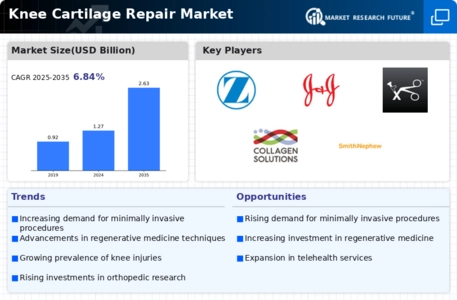Growing Awareness of Joint Health
There is a notable increase in public awareness regarding joint health and the importance of early intervention for knee issues. Educational campaigns and initiatives aimed at promoting joint health are becoming more prevalent, which is likely to influence the Knee Cartilage Repair Market positively. As individuals become more informed about the risks associated with untreated knee injuries, they may seek timely medical attention, leading to higher demand for cartilage repair solutions. This heightened awareness is also encouraging healthcare providers to adopt preventive measures and innovative treatment options, thereby fostering growth within the Knee Cartilage Repair Market. The emphasis on proactive healthcare could result in a shift towards more comprehensive treatment plans that prioritize long-term joint health.
Increasing Healthcare Expenditure
Rising healthcare expenditure across various regions is a significant factor influencing the Knee Cartilage Repair Market. As healthcare budgets expand, there is a greater allocation of resources towards advanced medical treatments, including knee cartilage repair. Data suggests that healthcare spending has been on an upward trajectory, with many countries investing in orthopedic care and rehabilitation services. This trend is likely to facilitate access to cutting-edge treatments and technologies, thereby enhancing patient outcomes. Furthermore, increased funding for research and development in the Knee Cartilage Repair Market may lead to the introduction of novel therapies and improved surgical techniques, ultimately benefiting patients and healthcare providers alike.
Rising Incidence of Knee Injuries
The increasing prevalence of knee injuries, particularly among athletes and the aging population, is a primary driver of the Knee Cartilage Repair Market. Studies indicate that knee injuries account for a substantial percentage of sports-related injuries, with estimates suggesting that approximately 25 percent of all sports injuries involve the knee. This trend is further exacerbated by the aging demographic, as older individuals are more susceptible to degenerative knee conditions. Consequently, the demand for effective cartilage repair solutions is likely to rise, propelling market growth. The Knee Cartilage Repair Market is expected to witness a surge in innovative treatment options, including minimally invasive procedures and regenerative therapies, to address this growing need.
Advancements in Regenerative Medicine
The field of regenerative medicine is rapidly evolving, offering promising solutions for knee cartilage repair. Techniques such as stem cell therapy and tissue engineering are gaining traction, potentially transforming the Knee Cartilage Repair Market. Research indicates that these advanced therapies may enhance healing and restore function more effectively than traditional methods. For instance, stem cell treatments have shown potential in regenerating cartilage tissue, which could lead to improved patient outcomes. As these technologies continue to develop, they are likely to attract significant investment and interest, further driving the growth of the Knee Cartilage Repair Market. The integration of these innovative approaches may also lead to a shift in treatment paradigms, emphasizing the importance of personalized medicine.
Technological Innovations in Surgical Techniques
Technological advancements in surgical techniques are playing a crucial role in shaping the Knee Cartilage Repair Market. Innovations such as arthroscopy and robotic-assisted surgeries are enhancing the precision and effectiveness of knee repair procedures. These technologies not only minimize recovery times but also improve surgical outcomes, which is likely to attract more patients seeking treatment. Data indicates that minimally invasive techniques are becoming increasingly popular, as they offer reduced pain and quicker rehabilitation. As these surgical innovations continue to evolve, they are expected to drive the growth of the Knee Cartilage Repair Market by providing patients with safer and more effective treatment options.

















Leave a Comment